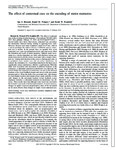The effect of contextual cues on the encoding of motor memories
| dc.contributor.author | Howard, IS | |
| dc.contributor.author | Wolpert, DM | |
| dc.contributor.author | Franklin, DW | |
| dc.date.accessioned | 2015-07-18T23:13:21Z | |
| dc.date.available | 2015-07-18T23:13:21Z | |
| dc.date.issued | 2013-05-15 | |
| dc.identifier.issn | 0022-3077 | |
| dc.identifier.issn | 1522-1598 | |
| dc.identifier.uri | http://hdl.handle.net/10026.1/3447 | |
| dc.description.abstract |
<jats:p> Several studies have shown that sensory contextual cues can reduce the interference observed during learning of opposing force fields. However, because each study examined a small set of cues, often in a unique paradigm, the relative efficacy of different sensory contextual cues is unclear. In the present study we quantify how seven contextual cues, some investigated previously and some novel, affect the formation and recall of motor memories. Subjects made movements in a velocity-dependent curl field, with direction varying randomly from trial to trial but always associated with a unique contextual cue. Linking field direction to the cursor or background color, or to peripheral visual motion cues, did not reduce interference. In contrast, the orientation of a visual object attached to the hand cursor significantly reduced interference, albeit by a small amount. When the fields were associated with movement in different locations in the workspace, a substantial reduction in interference was observed. We tested whether this reduction in interference was due to the different locations of the visual feedback (targets and cursor) or the movements (proprioceptive). When the fields were associated only with changes in visual display location (movements always made centrally) or only with changes in the movement location (visual feedback always displayed centrally), a substantial reduction in interference was observed. These results show that although some visual cues can lead to the formation and recall of distinct representations in motor memory, changes in spatial visual and proprioceptive states of the movement are far more effective than changes in simple visual contextual cues. </jats:p> | |
| dc.format.extent | 2632-2644 | |
| dc.format.medium | Print-Electronic | |
| dc.language | en | |
| dc.language.iso | eng | |
| dc.publisher | American Physiological Society | |
| dc.subject | motor learning | |
| dc.subject | visual cues | |
| dc.subject | interference | |
| dc.subject | dynamic adaptation | |
| dc.subject | state-dependent learning | |
| dc.title | The effect of contextual cues on the encoding of motor memories | |
| dc.type | journal-article | |
| dc.type | Article | |
| plymouth.author-url | https://www.ncbi.nlm.nih.gov/pubmed/23446696 | |
| plymouth.issue | 10 | |
| plymouth.volume | 109 | |
| plymouth.publication-status | Published | |
| plymouth.journal | Journal of Neurophysiology | |
| dc.identifier.doi | 10.1152/jn.00773.2012 | |
| plymouth.organisational-group | /Plymouth | |
| plymouth.organisational-group | /Plymouth/Faculty of Science and Engineering | |
| plymouth.organisational-group | /Plymouth/Faculty of Science and Engineering/School of Engineering, Computing and Mathematics | |
| plymouth.organisational-group | /Plymouth/REF 2021 Researchers by UoA | |
| plymouth.organisational-group | /Plymouth/REF 2021 Researchers by UoA/UoA11 Computer Science and Informatics | |
| plymouth.organisational-group | /Plymouth/Users by role | |
| plymouth.organisational-group | /Plymouth/Users by role/Academics | |
| dc.publisher.place | United States | |
| dc.identifier.eissn | 1522-1598 | |
| dc.rights.embargoperiod | Not known | |
| rioxxterms.versionofrecord | 10.1152/jn.00773.2012 | |
| rioxxterms.licenseref.uri | http://www.rioxx.net/licenses/all-rights-reserved | |
| rioxxterms.type | Journal Article/Review |


